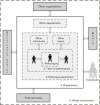Factors affecting the implementation and use of electronic templates for histopathology cancer reporting
- PMID: 24492317
- PMCID: PMC4035753
- DOI: 10.1097/PAT.0000000000000065
Factors affecting the implementation and use of electronic templates for histopathology cancer reporting
Figures



Similar articles
-
Template reporting matters--a nationwide study on histopathology reporting on colorectal carcinoma resections.Hum Pathol. 2011 Jan;42(1):36-40. doi: 10.1016/j.humpath.2010.06.009. Epub 2010 Sep 24. Hum Pathol. 2011. PMID: 20869747
-
Structured electronic health records.Tidsskr Nor Laegeforen. 2014 Feb 25;134(4):431-3. doi: 10.4045/tidsskr.13.1575. Tidsskr Nor Laegeforen. 2014. PMID: 24569746 English, Norwegian.
-
Using electronic medical records for research.Eur J Gen Pract. 2005 Mar;11(1):2-4. doi: 10.3109/13814780509178008. Eur J Gen Pract. 2005. PMID: 15841056 No abstract available.
-
Cancer biomarkers: the role of structured data reporting.Arch Pathol Lab Med. 2015 May;139(5):587-93. doi: 10.5858/arpa.2014-0082-RA. Epub 2014 Oct 2. Arch Pathol Lab Med. 2015. PMID: 25275812 Review.
-
A review of medical terminology standards and structured reporting.J Vet Diagn Invest. 2018 Jan;30(1):17-25. doi: 10.1177/1040638717738276. Epub 2017 Oct 15. J Vet Diagn Invest. 2018. PMID: 29034813 Free PMC article. Review.
Cited by
-
Automated Generation of Synoptic Reports from Narrative Pathology Reports in University Malaya Medical Centre Using Natural Language Processing.Diagnostics (Basel). 2022 Apr 1;12(4):879. doi: 10.3390/diagnostics12040879. Diagnostics (Basel). 2022. PMID: 35453927 Free PMC article.
-
Implementation and use of electronic synoptic cancer reporting: an explorative case study of six Norwegian pathology laboratories.Implement Sci. 2014 Aug 20;9:111. doi: 10.1186/s13012-014-0111-2. Implement Sci. 2014. PMID: 25138817 Free PMC article.
-
Cytological evaluation of breast lesions in symptomatic patients presenting to Kenyatta National Hospital, Kenya: a retrospective study.BMC Womens Health. 2015 Dec 15;15:118. doi: 10.1186/s12905-015-0278-y. BMC Womens Health. 2015. PMID: 26667228 Free PMC article.
-
Does standardised structured reporting contribute to quality in diagnostic pathology? The importance of evidence-based datasets.Virchows Arch. 2016 Jan;468(1):51-9. doi: 10.1007/s00428-015-1834-4. Epub 2015 Aug 28. Virchows Arch. 2016. PMID: 26316184 Review.
-
The effects of implementing synoptic pathology reporting in cancer diagnosis: a systematic review.Virchows Arch. 2016 Jun;468(6):639-49. doi: 10.1007/s00428-016-1935-8. Epub 2016 Apr 21. Virchows Arch. 2016. PMID: 27097810 Free PMC article.
References
-
- Zarbo RJ. Interinstitutional assessment of colorectal carcinoma surgical pathology report adequacy. A College of American Pathologists Q-Probes study of practice patterns from 532 laboratories and 15,940 reports. Arch Pathol Lab Med 1992; 116:1113–1119 - PubMed
-
- Casati B, Bjugn R. Structured electronic template for histopathology reporting on colorectal carcinoma resections: five-year follow-up shows sustainable long-term quality improvement. Arch Pathol Lab Med 2012; 136:652–656 - PubMed
-
- Ellis DW. Surgical pathology reporting at the crossroads: beyond synoptic reporting. Pathology 2011; 43:404–409 - PubMed
-
- Srigley JR, McGowan T, Maclean A, et al. Standardized synoptic cancer pathology reporting: a population-based approach. J Surg Oncol 2009; 99:517–524 - PubMed
Publication types
MeSH terms
LinkOut - more resources
Full Text Sources
Other Literature Sources
